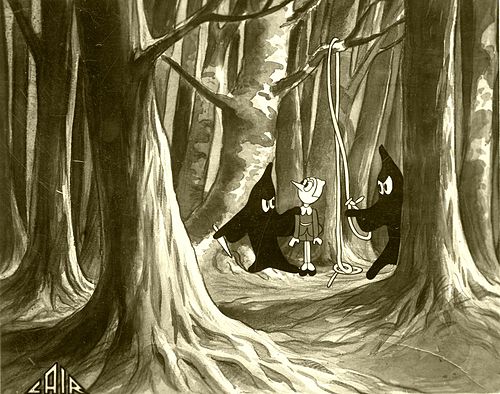 UnAmerican Animation: Rockin' Outside the USA
UnAmerican Animation: Rockin' Outside the USA
Of course, this is not just going to be the history of American animation, and while the USA was the forerunner and leader for a very long time in animation – both on film and later TV – there were others working in the field, and we will of course be examining their work. However, at this stage I can only find a small handful of animations produced outside of America (if you can trust Wikipedia) so I'm going to talk about them now, before I refer back to Disney.
Timeline: 1917-1937

Argentina is not the sort of place you immediately think of when you think of animation, but believe it or not, that's where the recognised very first animated feature film is supposed to have originated. Lost to the mists of time now, sadly, it was called
The Apostle (
El Apostolo) and though you might think it from the title (as did I) it is not in fact a religious film chronicling the lives of Jesus's disciples in the Bible. Rather, it is a satirical film lampooning the President of Argentina, who ascends into Heaven (I'm not sure if he dies) and uses the thunderbolts there to cleanse Buenos Aires of its corruption. As a result, the entire city burns. It might be ironic to reflect that the only copy of this important and historic film was lost to a fire in the studios of Quirino Cristiani, who directed it, and who is seen as one of the original fathers of animation. Nothing survives of the film, but there was a documentary called
Quirino Cristiani: The Mystery of the First Animated Movies, which attempted to recreate the film. All I can get of that though is this one-minute clip. It's interesting to note that Cristiani is hailed as one of “the men who foreran Disney”, which not only acknowledges Walt's position as the first true animator, but claims that Cristiani and his people were doing this almost a decade before Mickey Mouse came to the big screen. Amazingly, this feature film was over seventy minutes long, which, if it wasn't already accepted as being the first feature animation, would certainly give it the honour of being the longest.
Oh, I also found this:
Whether any irony was intended or not, Cristiani's next feature, released the following year, was titled
Without a Trace (
Sin Dejar Rostros). This too was a political film, based around the exploits of Baron von Luxburg, a German commander who tried to blame the Allies (known as the Entente) in World War One for the sinking of an Argentinian ship which he himself had arranged, and thereby draw Argentina into the First World War on the side of the Germans. Unfortunately for von Luxburg, there were survivors and they all clearly identified the attacker as a German ship.
The only other information about this film is that it was confiscated by the War Ministry, on the orders of the President, who presumably did not wish to have it cause an international incident, particularly as the war was by then winding down and would end that year.
Cristiani's only other major work was
Peludópolis, another political satire, but events conspired against him, both with the ousting of the President halfway through, the arrival of the Great Depression and the death of the former President, all resulting in his withdrawing the film from circulation. This, too, vanished in the fire that consumed the film laboratories, though I read now this did not happen until the fifties, which kind of negates the possibility of any irony in the title of his second movie. With the rise of Disney and the eventual domination of Mickey Mouse, Cristiani gave up animation and he died in 1984.

Although, as we'll see later, with Hitler in power the Nazi propaganda machine was not above using grossly caricatured cartoons to defame its enemies and promote its ideals, I can only find one animation that was created by a German prior to the rise of the Nazi party.
Die Abenteur des Prinzen Achmed (
The Adventures of Prince Achmed) was, in traditional German manner, a fairytale, though the subject of the animation looks to the
Arabian Nights for its substance (unsurprising, given the name of the eponymous prince!) and was created by Lotte Reiniger. She was a pioneering animator whose work went on to be recognised even by Disney himself, who used her camera techniques to animate part of his famous
Fantasia sequence, and indeed her influence extends even to today, with the Harry Potter franchise utilising her mode of animation.
If you've ever seen Japanese shadow puppet theatre, or even the old advertisement for
Metz schnapps, featuring the angular Judderman, you'll have a decent idea what to expect here. It's dark-on-light, with the characters moving stiffly, jerking around the screen, the former black while the latter changes colour, though only per scene: in one scene it is green, the next blue, a third orange and so on, so that the background, though changing, is static when a figure is upon it (static as in, the colour does not change) and only changes for the next scene, presumably to give some interest to an otherwise black animation. Her style was called silhouette animation, and involved cardboard cut-outs and figures of lead manipulated before a camera. It allows little in the way of variation, but considering the time we're talking about here must have been seen as pretty inventive. Still, it's clear to see the yawning gulf between what was happening in Europe (what very little there was) and the revolution going on in America. In every possible and conceivable way, the USA was light-years ahead of any other country.
It's kind of hard to get a feel for what's going on, given that you're basically looking at shadows, and the fact that the text is, of course, as you would expect, all in German doesn't help either. There's no speech, just music as a background, though I do note one figure (a genie perhaps, as Aladdin is mentioned?) does manage to look quite scary, so that's quite a feat in and of itself. Nevertheless, I find myself unwilling to sit through the whole thing, but you can if you want, as I have dropped the video in here. You can also read the full story, including the plot, here.
https://en.wikipedia.org/wiki/The_Ad..._Prince_Achmed

Although Wiki has this under the Nazi banner – presumably because they were in power when it was created – I can find hardly any information about it, never mind anything to suggest it was part of Nazi propaganda, so I'm keeping it under the general German flag, and not under the Swastika, as I will be categorising later actual Nazi propaganda films. This was released in 1937 and is called
The Seven Ravens (
Die siebe Raben) but other that that, and the fact that it was a stop-motion animation, based on the fairytale by the Brothers Grimm, I got nothing.

Based on Goethe's tales of the cunning fox,
Le Roman de Renard (The Tale of the Fox) was French animator Ladislas Starevich's first full-length animated feature, and though completely unknown outside of France at the time, beat
Snow White and the Seven Dwarves to the spot of first full-length animated film by eight months. Unlike
Snow White though,
Renard made use of puppet animation, and unlike our German friend, Starevich's tale is played for laughs, with the ever-cunning Renard convincing the hangman to loosen his rope, right at the opening of the cartoon, as it is, quote, too tight. The animation is really quite spectacular, even if it is puppets and not drawings. Take a look.
Luckily, this one has English subtitles, so the wit of the fox is not lost on us non-Francophiles. I have to admit though, I find myself wondering if this is somehow retouched or redone in some way, as it seems years ahead of its time. Decades, even. If this is typical of what the French were putting out in 1926, how did they not become a force in animation much earlier? Just staggering, and shows that the Americans weren't the only ones who could bring a story to life on a screen. Amazing.
Yeah, sorry: my brain just returned from the cleaners, and now I can think straight. Idiot. Of course that wasn't the original: look at the quality of the animation. Nobody, not even Disney, was doing that so early. That's obviously a remake. I can only get a few small clips of the original, but guess what? It's in black and white. I really must remember to ring that guy about buying the Brooklyn Bridge: sounded like a good deal!
(At least watching the “new” version does, as I say, allow you to follow the story if you don't speak French). The film was completed in 1930 but problems adding a sound track led to its release being delayed till 1937, but still pre-empting Disney's full-length film.

Not to be outdone, those crazy Russians were also at it. Well, technically they were Soviets back then, as Russia was part of the USSR, the Union of Soviet Socialist Republics, and the world's biggest bastion of Communism. Small wonder then that when Alexander Ptushko and his team of animators reimagined the classic story
Gulliver's Travels they would put a Communist twist on it. I've no intention of going into the skewed politics of it all – where capitalism was, typically, seen as the evil enemy and glorious mother Russia the hero etc etc – but if you want to sit through over an hour of it, here you go.
What is important is that it was the first animation to make extensive use of puppetry, before even Ladislas Starevich above, coming out in 1935, two years before
Le Roman de Renard although apparently only begun two years
after the French film. I guess that's what happens when you can call on the might of the Kremlin to provide your musicians and your technology. Maybe. Anyway it made it first, and so has gone down in history as the first full-length puppet animation.

Although there is no surviving copy of
The Adventures of Pinocchio (
Le Avventure di Pinocchio), because it was never completed, it deserves a mention not only because it would also have beaten
Snow White had it been released, but it takes as its subject matter another fairy tale that Walt Disney would make famous, the puppet who longs to be a real boy,
Pinocchio. Production issues bedevilled the project, which had a budget (surely undreamed-of at the time) of one million (and that's Pounds, not Lira!) and it was abandoned. All I can offer you are some stills from its Wiki page, the only frames that survived this ill-fated attempt to be the first Italian feature-length animation.


The only other example of early Italian animation seems to have been based on the Three Musketeers, (for whatever reason it was called
The Four Musketeers ([i[I quattro moschettieri[/i])though sadly, again, this has not survived or is at least not known to be available. Interesting though, as it was another puppet animation and apparently used over
eight thousand actual puppets! Talk about pulling a lot of strings to get things done!

Sorry...
That more or less covers it for non-American full-length animated movies before 1940. Most of the forties was of course dominated by America, mostly Disney's works, but there were a few who worked outside of the US. However, given that after the release of
Snow White there wasn't too much interest in non-American animation, I'll stop this section here for now, and then pick it up later, when we've paid proper tribute to Walt and his team.